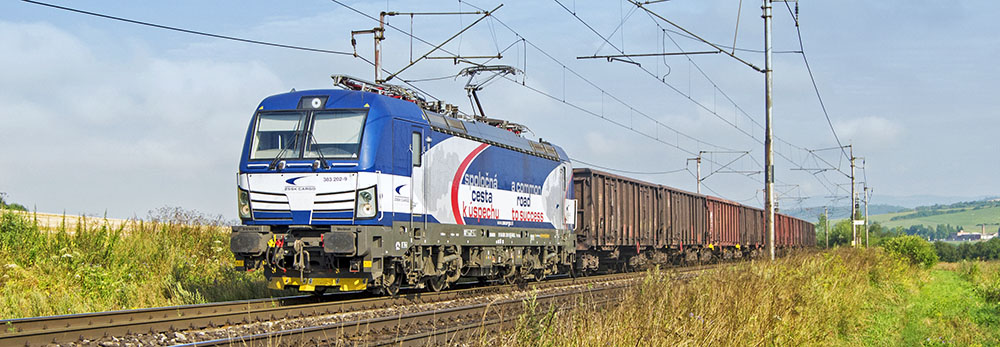Prihláste sa na odber noviniek


It is only a year since regular mixed freight trains were established in cooperation with ZSSK CARGO on the Slovak and DB Cargo on the European side leave Slovakia. While there were initially five trains a week to Germany and back, today there are already seven trains in both directions and, on most days, more routes have to be booked.
If you decide how to transport your goods between Western Europe and Slovakia, you can load them on trucks and put the load on the planet alongside the roads. Or you can use the sustainable way - railway. All you have to do is contact the regional or commodity manager of ZSSK CARGO. They will help you with the delivery of wagons for loading, transfer by regional trains to the nearest marshaling yard - and from there they will get by mixed freight trains to classification yard in Žilina-Teplička. Here, all shipments from Slovakia are combined and Slovakia Shuttle is formed. This train, run in cooperation with ZSSK CARGO and DB Cargo, transports various goods not only to Germany. DB Cargo, as the largest freight carrier in Europe, can further direct the wagons with your goods on regular trains that run in its network to Spain, Italy, Switzerland, France, Belgium, the Netherlands, Denmark, Poland, and Sweden.
Nine Routes a Week are Not Uncommon
Slovakia Shuttle is proof that rail transport not only has the potential to grow. It has that potential even in the area of individual wagonloads. Although the wagons cover most of the distance while traveling across Europe, they can only be assembled to Slovakia Shuttle when regional and mixed freight trains in Slovakia, composed of individual wagon consignments and groups of wagons, are involved in the logistical chain. That is why supporting wagonload shipments in Slovakia is so important. If this happens, Slovakia Shuttle can be a good example of the increase in rail transport. Of the original 5 routes per week between Germany and Slovakia, it is common after a year for 9 trains to pass in both directions per week. And this trend continues in 2022. A new record was set in January: more trains were driven than days in the month.
Transfer of Volumes from the Road to the Rail in Practice
With its stability and reliability, Slovakia Shuttle gained in popularity. Regular customers increase the transported volumes and new customers are coming. Slovakia Shuttle stopped the decline in rail transport to and from Germany, on the contrary, the railway share has significantly improved. And with it the environment. There are 48 fewer trucks on the road between Slovakia and Germany every day. In 2021, there were a total of at least 17,400 trucks less on the roads thanks to Slovakia Shuttle.
Broad Variety of Transported Goods
The commodities that Slovakia Shuttle hauls, are really diverse. The metallurgical industry was at the beginning of these shipments and it still maintains a significant position in the composition of goods. However, volumes in the automotive, paper, wood, and chemical industries were gradually added and growing. Intermodal transports also find their share here. Slovakia Shuttle trains are especially important in exports from Slovakia when 98% of them are transported loaded.
The Potential for Growth is Hitting the Limits of Infrastructure
Slovakia Shuttle has still not reached its limits. As Germany and Western Europe are the main export markets for the Slovak industry, even more goods can be transferred from rail to rail. However, there is still one "but". And that lies in the infrastructure. On one hand, railway infrastructure is being modernized throughout Europe. These short-term sufferings for long-term profit are necessary, but they reduce the throughput of the lines. And the speed of transport by rail must remain competitive. On the other hand, there is a modernization of lines that are not in favor of rail freight. Faster corridors often cut off railway sidings and side-tracks in stations, and during the reconstruction, the need for longer side tracks is little taken into consideration. Longer side-tracks make it possible to transport more goods on one train, which increases its efficiency. Locomotives and wagons are both ready for this - there is only a lack of stations to make, for example, the 740-meter train across Europe, a reality. There are also insufficient investments in marshalling yards. Žilina Teplička is one good example that modernization can help a lot, but development is also needed in marshalling yards, such as Bratislava-East or Košice.
Railway companies are fighting hard to move as much goods as possible to the railways. With their day-to-day steps, they move thousands of percent by each wagon in favor of achieving 30% of EU freight transport by rail by 2030. Infrastructure must therefore keep pace with them so that success stories such as Slovakia Shuttle can develop and build the basis for other similar connections.
Photo: Natanael Tóth